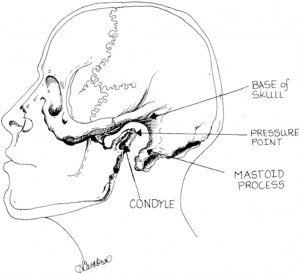Laryngospasm: Difference between revisions
Elcatracho (talk | contribs) |
Elcatracho (talk | contribs) |
||
| Line 49: | Line 49: | ||
==External Links== | ==External Links== | ||
https://5minuteairway.com/2017/03/24/beating-laryngospasm/ | |||
==References== | ==References== | ||
<references/> | <references/> | ||
Revision as of 17:21, 29 November 2020
Background
- Associated with ketamine (0.3%)
- Usually associated with large doses or rapid IV push
Causes
- Ammonia toxicity
- Medications
- Hypocalcemia
- Acute tetanus
- Ludwig's angina
- Acute laryngospasm
- Submersion injury
- Pulmonary chemical agents
- Pepper spray
- Smoke inhalation injury
- Caustic cocktail
Clinical Features
- Apnea may be the only sign in complete closure
- Partial closure can manifest as stridor, guttural noises, and paradoxical chest movement
Differential Diagnosis
Evaluation
Workup
- Typically not indicated
Diagnosis
- Typically a clinical diagnosis
Management

Apply pressure inwardly and anteriorly to the point labeled "Pressure Point" (Larson's Point) while applying a jaw thrust to relieve laryngospasm [1]
- Jaw thrust
- Place pressure on Larson's notch
- If jaw thrust and pressure are not sufficient, bag valve mask with PEEP
- If above do not resolve laryngospasm, sedate more deeply (propofol is the traditional choice, 0.5mg/kg)
- If deeper sedation does not resolve laryngospasm, paralyze and intubate
Disposition
See Also
External Links
https://5minuteairway.com/2017/03/24/beating-laryngospasm/
References
- ↑ Larson CP Jr. Laryngospasm--the best treatment. Anesthesiology. 1998 Nov;89(5):1293-4. doi: 10.1097/00000542-199811000-00056. PMID: 9822036.


